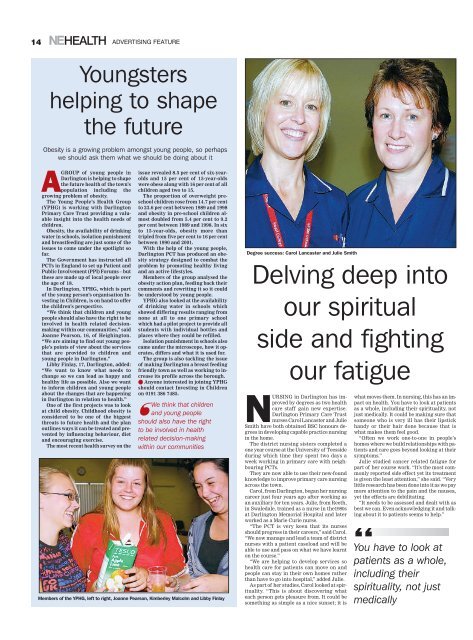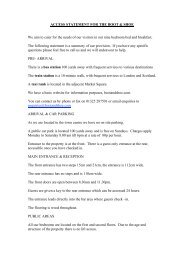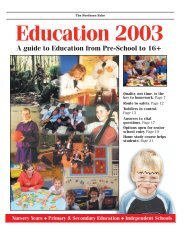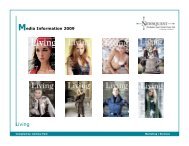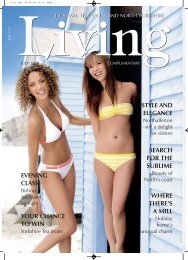SPORTS INJURY How to tackle it EXERCISE The power of Pilates ...
SPORTS INJURY How to tackle it EXERCISE The power of Pilates ...
SPORTS INJURY How to tackle it EXERCISE The power of Pilates ...
- No tags were found...
Create successful ePaper yourself
Turn your PDF publications into a flip-book with our unique Google optimized e-Paper software.
14 N E HEALTH ADVERTISING FEATUREYoungstershelping <strong>to</strong> shapethe futureObes<strong>it</strong>y is a growing problem amongst young people, so perhapswe should ask them what we should be doing about <strong>it</strong>AGROUP <strong>of</strong> young people inDarling<strong>to</strong>n is helping <strong>to</strong> shapethe future health <strong>of</strong> the <strong>to</strong>wn’spopulation including thegrowing problem <strong>of</strong> obes<strong>it</strong>y.<strong>The</strong> Young People’s Health Group(YPHG) is working w<strong>it</strong>h Darling<strong>to</strong>nPrimary Care Trust providing a valuableinsight in<strong>to</strong> the health needs <strong>of</strong>children.Obes<strong>it</strong>y, the availabil<strong>it</strong>y <strong>of</strong> drinkingwater in schools, isolation punishmentand breastfeeding are just some <strong>of</strong> theissues <strong>to</strong> come under the spotlight s<strong>of</strong>ar.<strong>The</strong> Government has instructed allPCTs in England <strong>to</strong> set up Patient andPublic Involvement (PPI) Forums – butthese are made up <strong>of</strong> local people overthe age <strong>of</strong> 18.In Darling<strong>to</strong>n, YPHG, which is par<strong>to</strong>f the young person’s organisation Investingin Children, is on hand <strong>to</strong> <strong>of</strong>ferthe children’s perspective.“We think that children and youngpeople should also have the right <strong>to</strong> beinvolved in health related decisionmakingw<strong>it</strong>hin our commun<strong>it</strong>ies,” saidJoanne Pearson, 16, <strong>of</strong> Heighing<strong>to</strong>n.“We are aiming <strong>to</strong> find out young people’spoints <strong>of</strong> view about the servicesthat are provided <strong>to</strong> children andyoung people in Darling<strong>to</strong>n.”Libby Finlay, 17, Darling<strong>to</strong>n, added:“We want <strong>to</strong> know what needs <strong>to</strong>change so we can lead as happy andhealthy life as possible. Also we want<strong>to</strong> inform children and young peopleabout the changes that are happeningin Darling<strong>to</strong>n in relation <strong>to</strong> health.”One <strong>of</strong> the first projects was <strong>to</strong> lookat child obes<strong>it</strong>y. Childhood obes<strong>it</strong>y isconsidered <strong>to</strong> be one <strong>of</strong> the biggestthreats <strong>to</strong> future health and the planoutlines ways <strong>it</strong> can be treated and preventedby influencing behaviour, dietand encouraging exercise.<strong>The</strong> most recent health survey on theissue revealed 8.5 per cent <strong>of</strong> six-yearoldsand 15 per cent <strong>of</strong> 15-year-oldswere obese along w<strong>it</strong>h 16 per cent <strong>of</strong> allchildren aged two <strong>to</strong> 15.<strong>The</strong> proportion <strong>of</strong> overweight preschoolchildren rose from 14.7 per cent<strong>to</strong> 23.6 per cent between 1989 and 1998and obes<strong>it</strong>y in pre-school children almostdoubled from 5.4 per cent <strong>to</strong> 9.2per cent between 1989 and 1998. In six<strong>to</strong> 15-year-olds, obes<strong>it</strong>y more thantripled from five per cent <strong>to</strong> 16 per centbetween 1990 and 2001.W<strong>it</strong>h the help <strong>of</strong> the young people,Darling<strong>to</strong>n PCT has produced an obes<strong>it</strong>ystrategy designed <strong>to</strong> combat theproblem by promoting healthy livingand an active lifestyles.Members <strong>of</strong> the group analysed theobes<strong>it</strong>y action plan, feeding back theircomments and rewr<strong>it</strong>ing <strong>it</strong> so <strong>it</strong> couldbe unders<strong>to</strong>od by young people.YPHG also looked at the availabil<strong>it</strong>y<strong>of</strong> drinking water in schools whichshowed differing results ranging fromnone at all <strong>to</strong> one primary schoolwhich had a pilot project <strong>to</strong> provide allstudents w<strong>it</strong>h individual bottles andplaces where they could be refilled.Isolation punishment in schools alsocame under the microscope, how <strong>it</strong> operates,differs and what <strong>it</strong> is used for.<strong>The</strong> group is also tackling the issue<strong>of</strong> making Darling<strong>to</strong>n a breast feedingfriendly <strong>to</strong>wn as well as working <strong>to</strong> increase<strong>it</strong>s pr<strong>of</strong>ile across the borough.● Anyone interested in joining YPHGshould contact Investing in Childrenon 0191 386 7485.❛We think that childrenand young peopleshould also have the right<strong>to</strong> be involved in healthrelated decision-makingw<strong>it</strong>hin our commun<strong>it</strong>iesMembers <strong>of</strong> the YPHG, left <strong>to</strong> right, Joanne Pearson, Kimberley Malcolm and Libby FinlayDegree success: Carol Lancaster and Julie Sm<strong>it</strong>hDelving deep in<strong>to</strong>our spir<strong>it</strong>ualside and fightingour fatigueNURSING in Darling<strong>to</strong>n has improvedby degrees as two healthcare staff gain new expertise.Darling<strong>to</strong>n Primary Care Trustnurses Carol Lancaster and JulieSm<strong>it</strong>h have both obtained BSC honours degreesin developing capable practice nursingin the home.<strong>The</strong> district nursing sisters completed aone year course at the Univers<strong>it</strong>y <strong>of</strong> Teessideduring which time they spent two days aweek working in primary care w<strong>it</strong>h neighbouringPCTs.<strong>The</strong>y are now able <strong>to</strong> use their new-foundknowledge <strong>to</strong> improve primary care nursingacross the <strong>to</strong>wn.Carol, from Darling<strong>to</strong>n, began her nursingcareer just four years ago after working asan auxiliary for ten years. Julie, from Reeth,in Swaledale, trained as a nurse in the1980sat Darling<strong>to</strong>n Memorial Hosp<strong>it</strong>al and laterworked as a Marie Curie nurse.“<strong>The</strong> PCT is very keen that <strong>it</strong>s nursesshould progress in their careers,” said Carol.“We now manage and lead a team <strong>of</strong> districtnurses w<strong>it</strong>h a patient caseload and will beable <strong>to</strong> use and pass on what we have learn<strong>to</strong>n the course.”“We are helping <strong>to</strong> develop services sohealth care for patients can move on andpeople can stay in their own homes ratherthan have <strong>to</strong> go in<strong>to</strong> hosp<strong>it</strong>al,” added Julie.As part <strong>of</strong> her studies, Carol looked at spir<strong>it</strong>ual<strong>it</strong>y.“This is about discovering whateach person gets pleasure from. It could besomething as simple as a nice sunset; <strong>it</strong> iswhat moves them. In nursing, this has an impac<strong>to</strong>n health. You have <strong>to</strong> look at patientsas a whole, including their spir<strong>it</strong>ual<strong>it</strong>y, notjust medically. It could be making sure thatsomeone who is very ill has their lipstickhandy or their hair done because that iswhat makes them feel good.“Often we work one-<strong>to</strong>-one in people’shomes where we build relationships w<strong>it</strong>h patientsand care goes beyond looking at theirsymp<strong>to</strong>ms.”Julie studied cancer related fatigue forpart <strong>of</strong> her course work. “It’s the most commonlyreported side effect yet <strong>it</strong>s treatmentis given the least attention,” she said. “Veryl<strong>it</strong>tle research has been done in<strong>to</strong> <strong>it</strong> as we paymore attention <strong>to</strong> the pain and the nausea,yet the effects are debil<strong>it</strong>ating.“It needs <strong>to</strong> be assessed and dealt w<strong>it</strong>h asbest we can. Even acknowledging <strong>it</strong> and talkingabout <strong>it</strong> <strong>to</strong> patients seems <strong>to</strong> help.”‘‘You have <strong>to</strong> look atpatients as a whole,including theirspir<strong>it</strong>ual<strong>it</strong>y, not justmedically


